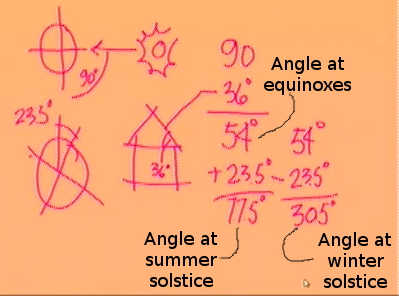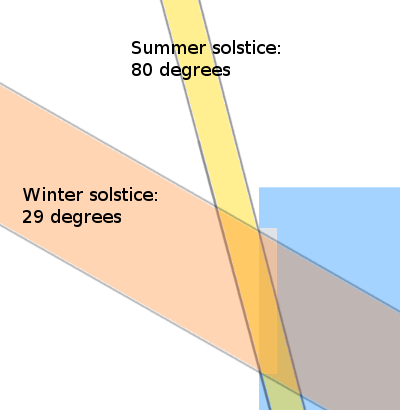
Sun angle math
 One of the reasons I'm plugging along with Will
Hooker's permaculture videos even though I know most of the
information is that I want to fill in any obvious gaps in my
scattered, homeschooled education. So I was thrilled to have
sun angles finally explained to me in a manner I could understand
in lecture 6.
One of the reasons I'm plugging along with Will
Hooker's permaculture videos even though I know most of the
information is that I want to fill in any obvious gaps in my
scattered, homeschooled education. So I was thrilled to have
sun angles finally explained to me in a manner I could understand
in lecture 6.
I've posted
previously about the
science behind sun angles, but the math has always eluded me. Luckily,
Hooker broke it down into simple arithmetic. All you have to
do to find the height of the sun above the horizon at the
equinoxes is to subtract your latitude from 90 degrees --- so, the
equinox sun is 54 degrees above the horizon at a latitude of 36
degrees. Since the sun angle at the equinox splits the
difference between summer and winter sun angles, people often use
this figure to calculate the tilt of their solar panels. If
you want to have the sun's rays striking a solar panel
perpendicularly at the equinox, just tilt the panel the same
number of degrees as your latitude --- 36.8 degrees here. If
you want a bit more efficiency from your panels in the winter,
tilt the panel a bit steeper; for a bit more energy in the summer,
tilt the panel more shallowly.
 In order to figure out the sun angle at the
summer and winter solstice, you need to understand that the earth
is tilted at an angle of 23.5 degrees. (This is what gives
us seasons.) At the summer solstice, you add the earth's
tilt to the equinox's angle --- so Will Hooker's sun angle at the
summer solstice is 77.5 degrees (and ours is 76.7). At the
winter solstice, you subtract the tilt of the earth, so for us the
sun angle at the winter solstice is 29.7 degrees. These two
sun angles are what you need to determine
overhang depths for passive-solar structures.
In order to figure out the sun angle at the
summer and winter solstice, you need to understand that the earth
is tilted at an angle of 23.5 degrees. (This is what gives
us seasons.) At the summer solstice, you add the earth's
tilt to the equinox's angle --- so Will Hooker's sun angle at the
summer solstice is 77.5 degrees (and ours is 76.7). At the
winter solstice, you subtract the tilt of the earth, so for us the
sun angle at the winter solstice is 29.7 degrees. These two
sun angles are what you need to determine
overhang depths for passive-solar structures.
This information is just what we needed as we plan
more energy-saving trailer retrofits!
Want more in-depth information? Browse through our books.
Or explore more posts by date or by subject.
About us: Anna Hess and Mark Hamilton spent over a decade living self-sufficiently in the mountains of Virginia before moving north to start over from scratch in the foothills of Ohio. They've experimented with permaculture, no-till gardening, trailersteading, home-based microbusinesses and much more, writing about their adventures in both blogs and books.
Want to be notified when new comments are posted on this page? Click on the RSS button after you add a comment to subscribe to the comment feed, or simply check the box beside "email replies to me" while writing your comment.
